Number of lines 1 (Phase I & II) Train length 6 & 9 coaches Track gauge Broad gauge | Daily ridership 100,000. Began operation November 1, 1995 Transit type Rapid transit | |
Native name சென்னை பெருந்திரள் விரைவுப் போக்குவரத்து அமைப்பு Number of stations 17 (21 upon completion) Website www.sr.indianrailways.gov.in | ||
The Chennai Mass Rapid Transit System, a state-owned subsidiary of Indian Railways, is a metropolitan elevated railway line operated by Southern Railways. It is the first elevated railway line in India. Although it is segregated from the Chennai Suburban Railway, they both are operated by Southern Railway and are integrated in a wider urban rail network. Built at a cost of ₹ 11,710 million, the line runs within the city limits from Chennai Beach to Velachery, covering a distance of 19.34 km (12.02 mi) with 17 stations, with an average daily ridership of 100,000 commuters a day. Connecting the central business area of old Madras with the IT corridor, the section has a potential capacity of 425,000 passengers a day. In 2011–2012, MRTS registered a revenue of ₹ 198.9 million, registering a 16.25 percent increase, with 134 trains plying across all the 17 stations.
Contents
- Planning
- Construction and opening
- Funding pattern
- Route description
- Stations
- Design
- Plans for using the empty space at MRTS stations
- Hours of operation and frequencies
- Patronage
- Finances
- Fares and ticketing
- Rolling stock
- Criticism
- Lack of integration with other modes of transport
- Inadequate maintenance and usage of station facilities
- Other issues
- Extension to St Thomas Mount
- History of construction of MRTS Phase 2 Extension
- Benefits
- Proposed extension to Villivakkam
- Planned transfer of operations to Chennai Metro
- Proposed Chennai to Cuddalore Port coastal railway corridor
- Trivia
- References
The MRTS is proposed to be taken over by the Chennai Metro Rail Limited thereby bringing all the elevated tracks and underground tracks inside the city under one organisation. Upon completion of the takeover, all current MRTS trains would become air conditioned and consequently, the fares would be raised to match that of the Chennai Metro. The takeover is expected to be completed by the year 2021.
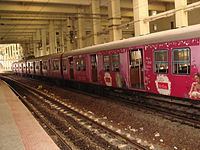
Planning
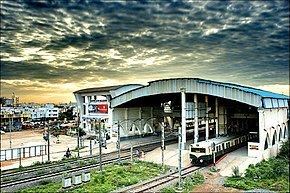
The well-established Chennai Suburban Railway network, which dates back to 1931, began services on the metre gauge line from Beach to Tambaram. Two more suburban networks, Chennai Central–Arakkonam and Chennai Central–Gummidipoondi began operations in 1985. In 1965, the Planning Commission set up a study team on metropolitan transport to assess the adequacy and limitation of existing transport facilities in the cities of Calcutta, Bombay, Madras and Delhi to determine the feasibility of different modes of transport and recommend phased programmes for development of transport facilities. In a means to supplement the existing suburban rail network in Chennai, a number of surveys were conducted in the 1960s including the surveys by the Madras Area Transportation Study Unit (MATSU), which was set up by the Planning Commission during 1968–1970 and the Metropolitan Transport Project (MTP), which was established by Indian Railways in July 1971. The surveys and studies identified eight important transport corridors, including the 39-km north–southeastern rail corridor along the Buckingham Canal. These were soon followed by a feasibility study conducted by RITES, an engineering and infrastructure enterprise of the Government of India, on behalf of the state government. The study results were submitted in 1975, suggesting a rail-based mass transit system between Kasturba Nagar and Manali Road.
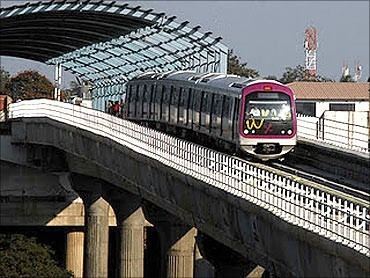
The system was envisaged as a 59.38 km (36.90 mi) loop line passing through Chennai Beach and Tiruvottiyur. In the 1980s, the government began planning for a new railway line inside the city. The suburban lines offered no connectivity to Central and South Madras (as the city was known then). Planning began in 1984.
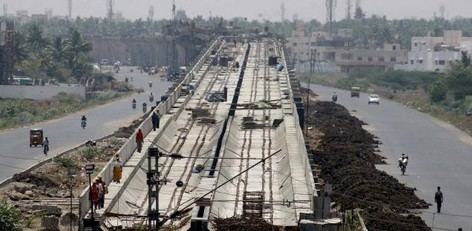
Since the rail line passes through congested parts of the city, an elevated rail system with an alignment along the Buckingham Canal was selected, as it would avoid land-acquisition problems. The MTP intended to implement the project in four phases:
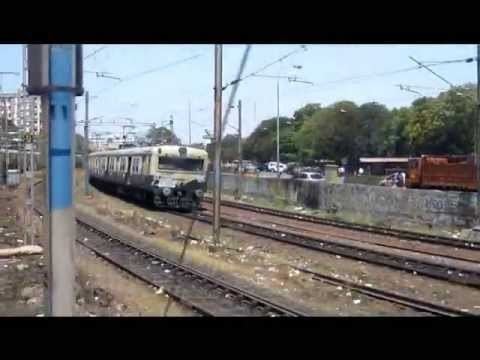
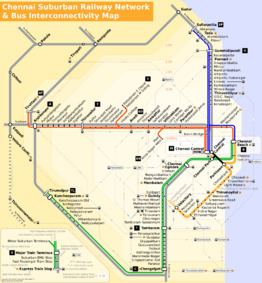
However, the current line is slated to not extend past St. Thomas Mount, as the Chennai Metro project is slated to use a similar alignment.
Construction and opening
Although the present system was planned in the 1970s and the 1980s and the project was taken up for implementation by the Government of India, Ministry of Railways in 1983–84 at an estimated cost of ₹ 534.6 million, it took nearly a decade for the first phase to construct and begin operation. Construction began in earnest in 1991. After many delays, the first phase was operational from Beach up to Chepauk in 1995 as the first elevated railway line in the country, and it was extended to Thirumyilai station in Mylapore in 1997. When the first phase between Chennai Beach and Thirumyilai opened in 1997, the project cost ₹ 2,690 million, compared to the initial estimate of ₹ 550 million in 1984. The patronage of the first phase turned out to be way lesser than the over-reckoned value of 603,000 passengers per day. In 1998, the Railway Board accorded sanction of executing Phase II of the project from Thirumayilai to Velachery.
The second phase of the project was taken up on the basis of the study conducted by RITES during 1987 and 1994 and taking into account population growth and the capacity of public transport system. The MRTS services were extended from Thirumaylai to Thiruvanmiyur on 27 June 2004, as part of its second phase. On 19 November 2007, the network was further extended from Thiruvanmiyur to Velachery at a cost of ₹ 7,690 million. The extended second phase of the project, connecting Velachery with St. Thomas Mount, is currently underway. However, changes to its original alignment have drawn fierce opposition from residents, some of whom have been asked to relocate.
The progress of different phases of the line is summarised in the following table:
Funding pattern
Phase I from Beach to Tirumailai was fully funded by the Southern Railways, and the state government gave the required land free of cost. Phase II between Tirumailai and Velachery was implemented with the state government bearing two-thirds of the project cost. For the extension of Phase II to St. Thomas Mount, the ratio remains the same as Phase II.
Route description
The Chennai MRTS route is largely elevated, with at-grade sections at its terminals. From Beach to Chennai Park Town station, the line runs at grade, parallel to the suburban railway network. Following Chennai Park Town station, the line's first phase becomes elevated and follows the course of the Buckingham Canal, which runs parallel to the Coromandel Coast. The line remains elevated for the alignment of the second phase up to Perungudi, after which it returns to an at-grade section at Velachery. The 19 km (12 mi) line from Chennai Beach to Velachery is 15 km (9 mi) elevated and 4 km (2 mi) at surface. The ongoing 5 km (3 mi) extension of the line from Velachery to St. Thomas Mount is also elevated.
In 2001, the Chennai Metropolitan Development Authority (CMDA) proposed a realignment of the MRTS route to St. Thomas Mount and combined it with the Inner Ring Road because it faced difficulties with land acquisition. The Government of Tamil Nadu accepted it in 2006, and an order confirming the changes was passed. About 186 hectares of land that were frozen from development till then were released. However, the alignment was changed further as the Department of Highways deviated from the approved alignment of the Inner Ring Road without consulting the CMDA or the Metropolitan Transport Project (MTP–Railways). These resulted in a deviation of the MRTS alignment in the order of 15 m (49 ft).
Stations
Snaking through the central region of Chennai, the alignment covers several significant landmarks of the city and currently has 17 stations. The Chennai Beach Junction is a hub terminal for several suburban trains, and, along with Chennai Fort station, it serves the commercial locations of Broadway and Parry's Corner. Chennai Park Town station is located opposite Chennai Central, which is a hub for both long-distance express trains and suburban trains. Places of tourist interests such as Parthasarathy Temple and Kapaleeshwarar Temple are located close to Thiruvallikeni and Thirumayilai MRTS stations, respectively. Marina Beach spans along the stretch of the Thiruvallikeni and Light House stations, in addition to the Chepauk station, which lies abutting the Chepauk Stadium. The MRTS also passes through those areas of Chennai where the information technology (IT) industry is located—while the Kasturba Nagar, Thiruvanmiyur and Indira Nagar stations are located on the IT corridor, the neighbourhoods of Perungudi, Taramani and Velachery also have IT establishments. The St. Thomas Mount station at the southern end of the alignment, upon completion, will have three different types of railway networks, namely, the suburban and long-distance express trains plying on the conventional tracks at grade level, the MRTS elevated station at level 1 and the Chennai Metro Rail at level 2. The station would be having an area of about 48,000 m2 (516,668 sq ft) and would be designed to integrate five different modes of transport including MTC buses.
Each station is designed by a different architect and is built to accommodate a 9-car train. Most stations also feature two-side platforms.
Design
In many aspects, the Chennai MRTS bears greater resemblance to the Chennai Suburban Railway as opposed to a true rapid transit line. While its route is segregated from the Chennai Suburban Railway for much of its length, it is sometimes considered to be an "elevated extension" of the suburban railway network, as opposed to a metro system. This is chiefly due to the fact that the MRTS uses the same gauge as the suburban system, thus allowing the movements of passengers between the existing suburban lines and the MRTS, although rakes are not moved directly from one system to another. Owing to this reason, the trains run on the MRTS are 'normal' EMUs and do not have automatic doors like a metro train. Ballastless track is used between Tirumailai and Velachery The elevated tracks are built at an average height of about 14 metres from the ground.
Plans for using the empty space at MRTS stations
There are various plans to use the empty space in the MRTS stations.
In Feb 2009, IRCTC envisaged to set up food stalls at 12 MRTS stations. But the food stalls have not materialised hitherto.
In Sep 2013, the IRCTC decideed to initially set up food stalls at three 3 key MRTS stations Tirumailai (Mylapore), Thiruvanmiyur and Velachery. The proposed plazas will have multiple shops and serve multi-cuisine food. The facility will be similar to the setup at Chennai Central railway station.
In October 2013, there are plans to open Amma Unavagams (Mother Canteens), the subsidised canteens run by the Tamil Nadu government, in the huge empty space of MRTS stations.
Commercial exploitation of the space in MRTS stations is not a new idea. However, over the years, many projects have failed to take off. Some years ago, CMDA had proposed the exploitation of space in nine stations across 11.16 km of the second phase of MRTS.
Hours of operation and frequencies
The route length between Chennai Beach and Velachery is 19.34 km (12.02 mi), with an average speed of 29 km/h (18 mph), with the current journey time has been 45 minutes.
The first train departs from Chennai Beach at 4:15 am, and the last one departs at 9:35 pm. From Velachery, the first train departs at 5:00 am to Chennai beach, with the last train departing Velachery at 10:20 pm. On Sundays, a total of 51 trips are operated. In the peak hours, nine-car trains are used, while six-car trains are operated during the remaining time. Nine-car rakes were introduced in 2008. All services, on the MRTS, were upgraded to 9 cars from Aug-2015 onwards. Two additional services promised in 2012 Railway Budget were introduced only in July 2013.
Patronage
The line currently transports less than 25 percent of its projected passenger capacity. The MRTS experiences a ridership of 78,000 commuters during weekdays and Saturdays. However, there has been a ridership increase from approximately 25,000 people in 2000 and 66,518 people in 2008. Incidentally, when the MRTS was extended up to Velachery in 2007, it saw a three-fold increase in the revenue. As of July 2015 the ridership is at 100,000 commuters a day. Commuters point out that the MRTS services could see higher patronage if the railway stations have better bus connectivity, proper maintenance and enough lighting and security.
Of the system's 17 stations, Chennai Park Town, Thirumayilai, Thiruvanmiyur and Velachery account for nearly 40 percent of the ridership. In a measure to increase patronage, the MRTS had adopted several schemes to draw potential passengers.
As the route passes close to some of the most famous temples of Chennai, the MRTS operates special trains during popular religious festivals such as the Vaikunta Ekadashi at Parthasarathy Temple in Triplicane and Arupathumoovar at the Kapaleeshwarar Temple in Mylapore. Special trains are also run during cricket matches at the M. A. Chidambaram Stadium at Chepauk, and air shows and Kaanum Pongal at the Marina Beach. and bus strikes.
Finances
For the 10-month period from April 2009 to January 2010, the MRTS earned a total revenue of ₹ 127.6 million: with a fare revenue of (₹ 122.1 million from ticketing sales, ₹ 2.6 million from advertisement sales and ₹ 2.9 million from parking contracts). This is compared with an estimated operating expense of about ₹ 230 million. The operational cost of the entire stretch is about ₹ 1.8 million per day while revenue generated amounts to only ₹ 0.3 million per day.
The average number of passengers and the revenue generated per day over the past years are listed below:
The MRTS network registered a 16.25-percent increase in revenue to ₹ 198.9 million in 2011–2012 period.
Fares and ticketing
The fare structure of the Chennai MRTS is integrated with that of the Chennai Suburban Railway, as both are operated by the Southern Railways. Unlike most rapid transit systems, and like the Chennai Suburban Railway, the Chennai MRTS maintains first-class passenger seating and does not have air-conditioned coaches. First class travel is only available aboard 9-car trains.
In addition to the fare scheme listed in the table, which is meant for one-time ticketed travel, the Southern Railways has monthly tickets and quarterly season tickets scheme for more frequent travellers.
Rolling stock
The Chennai MRTS uses both 6-car and 9-car electrical multiple unit trains, although the 9-car trains are more prevalent during peak hours and from Aug-2015 onwards all services are 9-cars only. The trains use overhead catenary for power supply and are broad gauge. A 9-car rake is typified by 3 motor coaches each at the front, the middle and the last. The motors are used to run the wheels of the train at a stipulated speed limit. The MRTS coaches have entry and exit on both sides. The EMU coaches are manufactured by the Integral Coach Factory, Chennai.
Criticism
Since its construction stages, the Chennai MRTS has had its share of controversies and criticism, including the cost-effectiveness of the route, accessibility, poor maintenance of stations, lack of intermodal transport facility, environmental concerns, budgeting issues and security issues. In light of these issues, which further impacted the line's low ridership, the MRTS has been working incrementally to change its image to Chennai's residents, by addressing and ameliorating the current conditions.
Lack of integration with other modes of transport
Some stations lack proper and safe approach roads, thus deterring passengers from reaching the stations. A study jointly conducted by Southern Railways and CMDA is currently in progress, and the survey results would help to identify the infrastructure problems that hinder ridership on MRTS and Mono Rail on the need to provide infrastructure like ramps, skywalks, nearby bus stops and pedestrians walkways. Access to the Chennai MRTS remains a crucial issue to the line's success, as it does not fully integrate with other modes of transportation in the city,.
Special focus would be on pedestrian facilities that would provide access to MRTS stations from nearby roads and bus stops, apart from identifying new feeder routes for the network. With the completion of connectivity to St. Thomas Mount (expected by 2017), the MRTS will be integrated into the grid of the Chennai Suburban Railway and the Chennai Metro Rail, thus sharing an intermodal transportation interchange with both the systems, when it is expected to reach its full potential due to uninterrupted movement of commuters across different rail lines in the city.
The state and central governments are also working together for the CMRL to takeover the Mass Rapid Transport System (MRTS) so that the latter will get a new shot of blood with modernised stations, integrated ticketing systems, better facilities for passengers, increased frequency of services taking into consideration passenger demands, and also lead to better maintenance.
Inadequate maintenance and usage of station facilities
The system has also been criticised for improper maintenance of stations and the infrastructure and on the windshields of cars parked below the stations, vandalism at several stations, seepage of rainwater through holes in the roofs of stations non-functional station amenities such as lifts and escalators, Station staff have expressed their concern over the Chennai MRTS's safety issues. and conducting various thefts In a recent bid to provide improve the security of the passengers using the network, it has been decided that the MRTS stations would have a single entry and exit point as it has been difficult for the RPF personnel to monitor multiple gates at the same time. According to sources, there is a 20% shortage in the strength of the railway protection force in MRTS stations.
Other issues
The MRTS has been criticised for environmental issues during its construction phase, due to the fact that much of the alignment was built along the banks of the Buckingham Canal. Although the canal itself has been in decline to a sewage, the Chennai River Restoration Trust has planned to revitalise and redevelop it. However, a 7.1-km section will remain impassable due to the presence of the MRTS. Another environmental impact caused by the erection of MRTS pillars in the canal is the blocking of the natural flow of storm water during rains. This has led to severe stagnation of rainwater in the neighbourhoods adjoining the canal.
Extension to St. Thomas Mount
Work on the 5 km (3 mi), three-station Phase II extension from Velachery to St. Thomas Mount began in 2008, with an original estimated completion of December 2010. The cost of the extension was estimated at ₹ 4,957 million. However, the line has been repeatedly postponed due to multiple issues during its construction process.
History of construction of MRTS Phase-2 Extension
Despite the delays, the extension from Velachery to St. Thomas Mount is currently underway. Track laying is progressing on the first 2 km (1 mi) stretch from Velachery. Of the remaining 1.5 km, the last 0.5 km (0 mi) from St. Thomas Mount is being constructed simultaneously with Chennai Metro. Litigation had previously prevented the work from being carried out in the last portion of track laying and the work had been stalled for nearly two years. However, a court ruling was passed in favour of the Chennai MRTS.
Design
The extension will be on an elevated structure whose alignment will be along the median of the Inner Ring Road (IRR) up to 3.585 km (2.228 mi) from Velachery, except for a small portion near Medavakkam Road. Beyond 3.585 km (2.228 mi), the alignment would deviate from IRR and would pass through the private built-up areas and terminate at St. Thomas Mount station. There are two stations en route, namely, Puzhithivakkam (1.85 km (1.15 mi) from Velachery) and Adambakkam (2.85 km (1.77 mi) from Velachery). All three stations, including St. Thomas Mount, will be on an elevated structure. Unlike stations on the Tirumailai–Velachery stretch, only minimum passenger amenities will be provided at the stations and no commercial complexes are planned. Due to spatial constraints, the stations are being built in a smaller design, with four staircases with escalators covering both sides of the road.
Benefits
The extension up to St. Thomas Mount is believed to benefit several people including those working in the IT establishments, residences and other offices near to the MRTS network. The patronage of the network is expected to increase significantly with this extension because St. Thomas Mount station will emerge as a single point interchange for 5 different modes of public transport – Public Buses, Southern Railway, the MRTS, Suburban South Line and Metro Line 2 - including a multi level terminal for three different suburban railway networks. Thus, the Mass Rapid Transit System (MRTS) is likely to be the missing link in the proposed three-way integration at St. Thomas Mount railway station when metro rail is up and running by mid-2014. It also has been further decided to terminate long distance trains there, so that the city traffic may get reduced.
Proposed extension to Villivakkam
The third and fourth phases of the MRTS were initially planned to connect St. Thomas Mount with Villivakkam and Villivakkam with Ennore, respectively. However, with the implementation of the Chennai Metro Rail, the plan for developing these two phases have been dropped, since these overlaps with the alignment of the Chennai Metro Rail.
Planned transfer of operations to Chennai Metro
Upon the inauguration of the Chennai Metro, the Chennai Metro Rail Limited(CMRL) is slated to assume the operations of the MRTS from the Southern Railway. The merger of operations will achieve overall integration and allow improved connectivity between the various rapid transit lines in Chennai. As part of a condition of the CMRL takeover, the current rolling stock will be replaced by new EMU units that will have air conditioning and automatic doors.
However it may take a long time for the project to take shape and there is a need co-operation between the different agencies involved. Manpower for MRTS is also a bottleneck for this take over.
Upon merging, CMRL would replace the present signalling system of MRTS, which allows only one service every six minutes. The six-minute gap is considered a barrier to any further upgradation of MRTS. A change in the signalling system to the metro rail technology would allow services every 400 m, which would improve the number of services and passenger strength.
Proposed Chennai to Cuddalore Port coastal railway corridor
In 2008, a proposal was initiated to construct a new railway line from Perungudi MRTS station in Chennai to Pondicherry via Old Mahabalipuram Road (OMR) and East Coast Road (ECR). The line emanating from Perungudi MRTS station is envisaged to be 179 km long and is expected to traverse via Sholinganallur, SIPCOT, Kovalam, Tiruporur, Mamallapuram, Kalpakkam, Koovathur, Cheyyur, Marakkanam, Kunimedu, Kuiyilappalayam, Jipmer in Pondicherry, Bahour, Varakalpattu, and Tirupadipuliyur to reach Cuddalore Port Jn. The railway line would run on an embankment. There was also a proposal to extend the line up to Karaikal via Mayiladuthurai. The railway line was sanctioned in the 2007 supplementary budget with an estimated cost of ₹ 5,230 million. However, there has been a delay owing to lack of funds and the project is expected to be completed in about 10 years. To expedite the project, the railway board is looking out for multiple options including private contribution, although the model is not yet finalised. There are also alternative plans of beginning or linking the line to Chengalpet. This railway corridor is expected to reduce the travel time between Chennai and Pondicherry to two hours against five hours along the present route via Villupuram. In Oct-2013, the state government started acquiring land for the 179-km project. At that time the project was estimated to cost ₹ 8,000 million.
